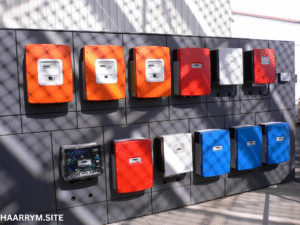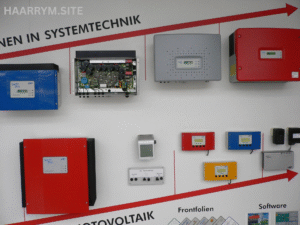Solar inverters are the unsung heroes making solar energy useable in our homes and companies in the modern renewable energy scene. Among the top brands in this field, Enphase Energy distinguishes itself particularly with its Enphase solar inverter technology. But why is Enphase so unique, and should you give it thought for your next solar project?
This all-inclusive guide delves deeply into what you need to know about Enphase solar inverters, including its operation, pros and downsides, financial concerns, competition comparison, and 2025 customer comments.
What Is an Enphase Solar Inverter?
Fundamentally, an Enphase solar inverter is a kind of microinverter system meant to convert direct current (DC) energy produced by solar panels into alternating current (AC) electricity able to run your house. Enphase inverters run separately on every solar panel, unlike conventional string inverters that control many panels at once, therefore increasing their dependability and efficiency.
Originally invented by Enphase, microinverter technology has evolved over time to be the preferred choice for small-business and home solar systems.
Key Features of Enphase Solar Inverters
1. Microinverter Technology
Each panel has its own inverter, which means:
-
Greater energy harvest
-
No single point of failure
-
Panel-level monitoring
2. IQ Series Inverters
The latest Enphase IQ series includes models like IQ7, IQ8, and IQ8+:
-
IQ7: Compact and highly efficient
-
IQ8: Grid-forming capabilities (works even during blackouts with Enphase battery)
-
IQ8+: Designed for higher-power panels
3. Enphase App and Monitoring
With Enphase Enlighten, users can:
-
Monitor solar production in real-time
-
Detect issues at the panel level
-
View historical data and analytics
4. Grid Independence
The Enphase IQ8 is one of the first microinverters capable of grid-forming. This means it can continue supplying power to essential appliances during an outage when paired with the Enphase battery system.
5. Compatibility and Scalability
Enphase inverters are compatible with:
-
Most residential solar panels
-
Enphase storage systems
-
Smart home integrations (like Tesla Powerwall alternatives)
Pros and Cons of Enphase Solar Inverters
✅ Pros:
-
Higher Efficiency: Since each panel operates independently, shading or debris on one panel won’t affect the entire array.
-
Scalability: Easy to expand your system by adding more panels and microinverters.
-
Safety: Lower DC voltage compared to string inverters.
-
Monitoring: Panel-level monitoring is ideal for optimizing performance.
-
Smart Features: Advanced mobile app and automation.
-
Durability: Typically includes a 25-year warranty, indicating long-term reliability.
❌ Cons:
-
Higher Initial Cost: More components mean a higher upfront cost than traditional inverters.
-
Complex Repairs: If a microinverter fails, you need to get on the roof to replace it.
-
Not Ideal for All Roof Designs: For large commercial installs, string inverters might be more economical.
How Does Enphase Compare to Other Inverter Brands?
| Feature | Enphase | SolarEdge | SMA |
|---|---|---|---|
| Inverter Type | Microinverter | String + Optimizer | String Inverter |
| Panel-Level Monitoring | Yes | Yes | No |
| Grid Independence | Yes (IQ8) | No | Limited |
| Warranty | 25 years | 12-25 years | 5-10 years |
| Efficiency Loss with Shading | Low | Medium | High |
Enphase generally outperforms its competitors when it comes to reliability, safety, and monitoring, especially in residential solar installations with complex roofs or partial shading.
Installation Process: What to Expect
Enphase systems are usually installed by certified professionals. Here’s what the process typically includes:
-
Site Assessment: Evaluation of your roof and energy usage.
-
System Design: Layout planning including panel placement and inverter setup.
-
Permits and Approvals: Handled by your installer.
-
Installation: Inverters are mounted on the back of each panel.
-
Activation: System is connected, tested, and goes live.
-
Monitoring Setup: Enlighten app is synced with your system.
Most installations take 1 to 3 days, depending on the system size.
Enphase Solar Inverter Pricing (2025)
The cost of Enphase solar inverters can vary depending on:
-
System size
-
Installer pricing
-
Region and incentives
-
Add-ons like batteries
Average Cost Breakdown (USD):
-
IQ7+ Microinverter: $150–$200 per unit
-
IQ8 Microinverter: $200–$300 per unit
-
Installation Costs: $0.30–$0.50 per watt (additional)
-
Total System (6kW): $12,000–$18,000 (including panels and labor)
While Enphase systems might cost more upfront than string inverters, the long-term reliability, energy savings, and monitoring benefits often justify the investment.
Enphase Storage Solutions: A Complete Energy Ecosystem
If you’re looking to go fully solar and off-grid, pairing your Enphase inverters with Enphase Encharge batteries makes perfect sense.
Benefits of Enphase Storage:
-
Seamless integration with IQ inverters
-
Modular design (add more storage anytime)
-
Blackout protection
-
App-based energy management
The IQ Battery 10T, for instance, offers 10.5 kWh of usable energy and integrates directly with the Enphase system.
Real User Reviews (2025)
⭐⭐⭐⭐⭐ – Sarah L., California
“I love the Enlighten app! I can see how much each panel produces. Even during cloudy days, I’m still generating power. The IQ8s are game-changers.”
⭐⭐⭐⭐ – Jason M., Texas
“Installation cost was a bit higher than expected, but it was worth it for the peace of mind. No issues even after 2 years.”
⭐⭐⭐⭐ – Priya S., New Jersey
“Our installer recommended Enphase for our shaded roof, and we’ve had no performance dips. I just wish the storage battery was more affordable.”
Ideal Use Cases for Enphase Solar Inverters
-
Homes with shading or multiple roof angles
-
People interested in energy independence
-
Users who want detailed performance tracking
-
Smaller commercial or residential systems
-
Solar systems with plans to expand in the future
If any of these sound like you, Enphase is probably one of your best bets.
Incentives and Tax Credits in 2025
Thanks to continued government support for renewable energy, many homeowners can offset the cost of an Enphase system:
-
Federal Solar Tax Credit: 30% off the total installation cost (U.S.)
-
State Rebates: Varies by region
-
Net Metering: Get credits for excess electricity sent back to the grid
-
Battery Incentives: In certain states (like CA or MA)
Always check local programs to maximize your savings.
Enphase vs String Inverter Systems: Final Verdict
| Category | Winner |
|---|---|
| Efficiency | Enphase |
| Cost | String Inverter |
| Monitoring | Enphase |
| Grid Independence | Enphase |
| Scalability | Enphase |
| Long-term ROI | Enphase |
Enphase microinverters excel in nearly every category, especially for residential solar projects. Although slightly more expensive, the benefits far outweigh the initial investment—making it one of the top inverter brands in 2025.

Final Thoughts: Is Enphase Right for You?
The Enphase solar inverter system is among the greatest ones available today if you appreciate efficiency, safety, and energy independence. Particularly with the IQ8 series’ debut, Enphase has confirmed its leadership in the microinverter space.
Enphase provides performance, dependability, and smart energy features that significantly impact your energy path whether your goal is to upgrade an existing system or install solar for the first time.
Frequently Asked Questions (FAQs)
❓Do Enphase inverters work without the grid?
Yes, especially the IQ8 series, which can operate in off-grid or grid-independent mode when paired with Enphase storage.
❓Are Enphase inverters compatible with all solar panels?
Enphase microinverters are compatible with most modern solar panels, especially those used in residential systems.
❓How long do Enphase inverters last?
They’re backed by a 25-year warranty and are designed to last at least that long under normal conditions.
❓Can I install Enphase inverters myself?
Installation should be done by a certified Enphase installer to ensure safety and warranty compliance.
Would you like me to also turn this article into an HTML web page, or help optimize it for Google Ads or blog CMS platforms like WordPress?
